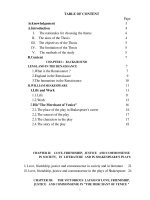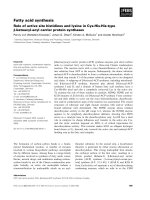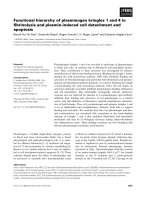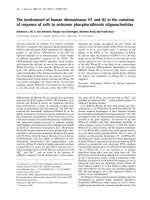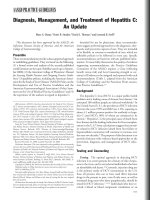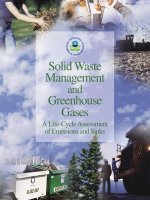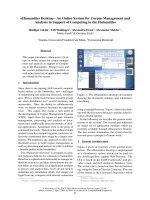Assesment of domestic waste management and treatment in nuoc hai town hoa an districs cao bang province
Bạn đang xem bản rút gọn của tài liệu. Xem và tải ngay bản đầy đủ của tài liệu tại đây (1.16 MB, 79 trang )
THAI NGUYEN UNIVERSITY
UNIVERSITY OF AGRICULTURE AND FORESTRY
DAM THI HOA
TOPIC TITLE:
ASSESSMENT OF DOMESTIC WASTE MANAGEMENT AND
TREATMENT IN NUOC HAI TOWN - HOA AN DISTRICT
CAO BANG PROVINCE
BACHELOR THESIS
Study mode
: Full-time
Major
: Environmental Science and Management
Faculty
: International Training and Development Center
Batch
: 2010 - 2015
Thai Nguyen, 23/01/2015
i
Thai Nguyen University of Agriculture and Forestry
Degree Program
Bachelor of Environmental Science and Management
Student name
DAM THI HOA
Student ID
DTN1053040049
Thesis Title
Assessment of domestic waste management and treatment
in Nuoc Hai town, Hoa An district, Cao Bang province.
Supervisor (s)
Dr. Tran Van Dien
Abstract
Nowadays, domestic waste is an urgent problem that we are facing. There are many
reasons of domestic waste but the main cause is due to the production activities and
human consciousness. Especially, in daily life, the huge amount of domestic waste that
people discharge which is not treated promptly will cause adverse effects. Residential,
hospitals, schools, markets… are considered as main sources of domestic waste,
particularly the area town where the need of daily garbage consumption of people is very
large. The large demand for using garbage means that high amount of solid waste will be
discharge. Untreated or not thoroughly treated garbage which is released from landfill has
a bad smell for the people living nearby the landfill. Likewise, domestic waste can have
negative impacts such as: affect the water environment, soil, air and urban landscape in
the town, affecting the health of people and the surrounding environment.
Besides the management of domestic waste is still loose, the environment
awareness of people is not high, the status of litter occurs still frequently. The town
is populated place, therefore the amount of garbage of people's daily to discharge
environment is increasing. Garbage treatment method mainly uses simple methods
such as bury and burning. In addition, methods of biological composting manure
also used quite common in our country.
Key words:
Domestic waste, solid waste, domestic waste
management, treatment, collected, transported.
Number of pages:
71
Date of submission:
23/01/ 2015
ii
ACKNOWLEDGEMENT
In the process of implementing the research topics: "Assessment of domestic
waste management and treatment in Nuoc Hai town -Hoa An district, Cao Bang
province-" I got the guide and help, encouragement of the teachers and the
students. I would like to express sincere gratitude to:
First and foremost, I wish to express sincere thanks to the Director Board of
Thai Nguyen University of Agriculture and Forestry, board of managers of
International Training and Development Center
and all the teachers have
dedicated teaching, the scientific knowledge and the valuable experience for me
during the training period, learning in school.
In particular, I take this opportunity to express profound gratitude and deep
regards to the supervisor Dr. Tran Van Dien who guided wholeheartedly, to
advise, imparted knowledge and valuable experience to help me during the study
and completed thesis.
Furthermore, I sincerely thanks to her uncle, elder brother and elder sister officers in
Division of Natural Resources and Environment - Hoa An district during the
implementing the research topic at the agency and to thanks to the officers of the
People's Committee of Nuoc Hai town and the whole households have helped me
during the investigation, interviewing, collecting data on Nuoc Hai area towns.
Finally, I would like to express our gratitude to the family, relatives and friends
who have helped me during the internship.
Due to the short time, limited professional qualification and less experience the
report may have inevitable mistakes. I very much look forward to the valuable
inputs and recommendation of teachers and friends to my thesis more perfectly.
Thank you very much!
Thai Nguyen, 23/01/ 2015
Student
Dam Thi Hoa
iii
TABLE OF CONTENTS
LIST OF FIGURES..........................................................................................1
LIST OF TABLES............................................................................................2
LIST OF ABBREVIATIONS...........................................................................3
PART I. INTRODUCTION .............................................................................4
1.1 Rresearch rationale ....................................................................................4
1.2. Research’s objectives...............................................................................5
1.2.1. The general objective.............................................................................5
1.2.2. The specific objective ............................................................................5
1.3. Research questions and hypotheses...........................................................6
1.4. Significance..............................................................................................6
1.5. Limitations ...............................................................................................6
PART II. LITERATURE REVIEW ................................................................7
2.1. Scientific basis of topics ...........................................................................7
2.1.1. Concepts related to waste.......................................................................7
2.1.2. Generations sources and domestic waste classification. .........................8
2.1.2.1. Generations sources ............................................................................8
2.1.2.2. Classification of domestic waste .........................................................9
2.1.3. Effect of domestic waste on the environment and human.....................11
2.1.3.1. The effect of domestic waste on the environment..............................11
2.1.3.2. The effect of domestic waste on public health...................................12
2.1.3.3. Domestic waste reduces the urban landscape ....................................12
2.2. The legal basis ........................................................................................13
2.3. Factual basis of the topics .......................................................................14
2.3.1. Status of domestic waste in the world ..................................................14
iv
2.3.2. The management and treatment of garbage in the world ......................17
2.3.3. Status of domestic waste in Vietnam....................................................20
2.3.4. The situation of management and treatment in Vietnam.......................25
2.3.4.1. Some of the methods and the garbage treatment technology in Vietnam ....26
2.3.4.2. Waste management situation in some provinces in the country .........28
2.3.5. Status of domestic waste in Hoa An District - Cao Bang Province .......31
PART III. METHODS ...................................................................................35
3.1. Material ..................................................................................................35
3.2. Methods..................................................................................................36
3.2.1. Study secondary data ...........................................................................36
3.2.2. Collecting primary data .......................................................................36
3.2.3. Determining the volume and composition of waste..............................37
3.2.4. Data analysis and processing ...............................................................37
3.2.5. Experts consultation.............................................................................38
PART IV. RESULTS......................................................................................39
4.1. Natural and socio-economic conditions in Nuoc Hai town- Hoa An disttict
- Cao Bang province......................................................................................39
4.1.1. Natural conditions................................................................................39
4.1.2. The socio-economic characteristics of the Nuoc Hai town. ..................43
4.1.2.1. Population and population distribution..............................................43
4.1.2.2. Economic conditions.........................................................................43
4.1.2.3. Infrastructure ....................................................................................43
4.1.2.4. Security order problems ....................................................................45
4.1.2.5. The collection system and waste disposal .........................................45
4.2. Assessment the status of domestic waste collection in Nuoc Hai town....45
v
4.2.1. Source of domestic waste generated in Nuoc Hai town. .......................45
4.2.2. The amount of waste generated and the components of domestic waste in
Nuoc Hai town. .............................................................................................47
4.2.2.1. The amount of waste generated.........................................................47
4.2.2.2. The components of waste in town .....................................................49
4.2.2.3. Status of the management, collection and transportation of domestic
waste in Nuoc Hai town.................................................................................50
4.3. Assessment of domestic waste management issues and treatment in Nuoc Hai
town...............................................................................................................55
4.3.1. The management .................................................................................55
4.3.2. The process of landfill and treatment. ..................................................57
4.3.3. Assessment of community awareness about the management of domestic
waste..............................................................................................................60
4.4. Proposed solutions improve the efficiency of domestic waste management
and treatment in Nuoc Hai town. ...................................................................61
4.4.1. Management solution...........................................................................62
4.4.2. Technical solutions ..............................................................................63
PART V: DISCUSSION AND CONCLUSION ............................................66
5.1. Discussion ..............................................................................................66
5.2. Conclusion..............................................................................................68
REFERENCES ...............................................................................................70
vi
LIST OF FIGURES
Figure 2.1. Chart source of waste generated.......................................................... 9
Figure 2.2. Diagram of waste treatment technology of U.S -Canada ....................19
Figure 2.3. Technology of domestic waste disposal in China ...............................20
Figure 2.4. Diagram of technology of domestic waste processing, Plant of
organic fertilizer Cau Dien - Hanoi ......................................................................31
Figure 2.5. Diagram of garbage collection system is being applied. .....................34
Finger 4.1. The components of garbage in the town .............................................50
Figure 4.2. Diagram organizations structure of urban environment branch Hoa
An district............................................................................................................51
Figure 4.3. The process of collection and transportation of garbage in Nuoc Hai
town. ...................................................................................................................53
Figure 4.4. Landfill in Nuoc Hai town ................................................................59
Figure 4.5. Some illustrations of dust-hole.........................................................65
1
LIST OF TABLES
Table 2.1. The definition components of domestic solid waste (DSW). ..............10
Table 2.2. The amount of solid waste generated in some countries ......................15
Table 2.3. The amount of solid waste generated in urban areas in Vietnam..........23
Table 2.4. The situation of solid waste generated in our country (by geographic
region) .................................................................................................................24
Table 2.5. The situation of waste collection in Nuoc Hai district in the recent
years (tons/year) ..................................................................................................32
Table 4.1. Land use status in Nuoc Hai town. ......................................................41
Table 4.2. The volume of domestic waste generated from the sources .................46
Table 4.3. The volume of waste generated in Nuoc Hai town ..............................47
Table 4.4. The average volume of garbage generated from households................48
Table 4.5. The components of garbage in the town ..............................................49
Table 4.6. The human resources serve for the collection, managing and disposal
of domestic waste in Nuoc Hai town....................................................................51
Table 4.7. The level of fees environmental sanitation collected in Nuoc Hai area
towns. ..................................................................................................................56
Table 4.8. Assessment of population community about management system of
domestic waste in Nuoc Hai town (%) .................................................................61
2
LIST OF ABBREVIATIONS
Abbreviations
Meaning
DW
Domestic waste
DSW
Domestic solid waste
EM
Effective Microorganism
JICA
The Japan International Cooperation Agency
MONRE
Ministry of Natural Resources and Environment
3
PART I. INTRODUCTION
1.1. Research rationale
In recent years, the economic and social development of our country has made
remarkable achievements, many lives have been improved. Our country is in the
process of industrialization, development and modernization and has made great
achievements in many fields. Along with the rapid progress of the country, the
goal of conserving the environment always has been the one of the main interest
of different Parties and the entire State. Environmental protection is both
objective and one of the basic content for sustainable development concerns.
However, the population and socio-economic growth rate are both growing,
people must adopt and their lives should be improved as well in response to the
changes, advancements and progress. On the other hand, the demands and or
daily consumption of everybody are getting bigger; hence, the volume of
domestic waste is increasing which indeed causes many serious problems
concerning environment protection. In Vietnam, in recent years environmental
pollution situation has become serious and most commonly lead to degradation
of land, water, air, especially in the large places like urban areas. The amount of
waste is increasing that greatly affect the environmental landscape - changes
resulting to negative tendencies and direct impact on the lives of many people.
Currently, environmental pollution is an urgent matter in almost every country
around the world. Nowadays, there are many methods to deal with, to mitigate
the consequences of this matter. In particular, the handling and garbage
collection meet many difficulties regarding both means and methods. Domestic
waste is currently one of the major problems of environmental pollution.
Domestic waste management is one of the top issues in our community which
contributes a lot to many challenges of today’s environment. Nowadays, the
4
issue of environmental protection and waste management activities are becoming
more urgent, and this must be a concern of the entire society and community.
However, if management is done sustainably and reasonable reuse of domestic
waste will be a source of cheap raw materials; this will bring economic benefits
to many individuals and contribute greatly to environmental protection and save
the earth’s natural resources.
Nuoc Hai town are the center political culture of Hoa An district, Nuoc Hai towns are
sector which has shown strong economic growth. However, the current status of general
waste and domestic waste in particular, have not been fully evaluated and audited,
Provided that this leads to difficulty in collection and waste management, no
appropriate measures on proper disposal which in return still protecting the environment
at the same time. So in the assessment of the current status of the management and
treatment of household waste is one of the vital problems of Nuoc Hai town.
Therefore the research topic: “Assessment of Domestic Waste Management and
Treatment in Nuoc Hai town - Hoa An district - Cao Bang province” was conducted
in Nuoc Hai town under the guidance of Dr. Tran Van Dien - Thai Nguyen University
of Agriculture and Forestry.
1.2. Research’s objectives
1.2.1. General objective
The general objectives of this project is to assess the current of domestic waste
management and treatment in the Nuoc Hai town area, and then proposes a
number of measures in accordance with the conditions of the town to mitigate
environmental pollution caused by the domestic waste.
1.2.2. Specific objective
+ To evaluate of domestic waste management status and treatment in the Nuoc Hai
town area.
5
+ To assess the awareness of the communities and people about domestic waste
management.
+ To propose some solutions to manage the domestic waste in a sustainable way.
1.3. Research questions and hypotheses
1. What is the current status of domestic waste in Nuoc Hai town?
2. How to manage and treat domestic waste in Nuoc Hai town?
3. What are solutions to manage domestic waste in study area?
1.4. Significance
+ The meaning of learning and scientific research
- Application of the knowledge gained from the school into reality.
- Enhance practical skills.
- Accumulation of work experience after graduation.
- Advanced knowledge on research and find reference material to gain efficiency.
+ Practical implication
-Assessing the amount of waste generated; collection situation, management and
disposal of domestic waste in Nuoc Hai town area.
+ Proposed management measures, domestic waste disposal in accordance with
the actual conditions of the town.
+ Raising awareness of the local people on the issues of environmental
protection.
1.5. Limitations
The study cannot include all the management issues and treatment of domestic
waste in Nuoc Hai town area. Because the short time study, the thesis was
restricted by many factors in the survey and investigation process about the
garbage in the study area.
6
PART II. LITERATURE REVIEW
2.1. Scientific basis of topics
2.1.1. Concepts related to waste
According to the Vietnam Environment Protection Act: the waste are material in
solid, liquid and gas produced from production, business and service activities or
other activities.(Law on Environmental protection, 2006).
+ Hazardous waste is waste that contains toxic elements, radioactive, flammable,
explosive, infectious, cause harmful on the environment and human health.
According to Article 3 of Decree 59/2007/ ND-CP dated April 09, 2007 of solid
waste management:
• Solid waste is material in solid which is discharged from the process of
production, business, services activities or other activities.
• Domestic waste is waste generated in living individuals, households and public
places.
• Solid waste collection is a set of activities, sorting, packing and temporary storage of
solid waste at collection points to the location or facility is the state agency authorized
approval.
• Transportation of solid waste is the process of transporting solid waste from the
generation places, collection, storage, and transfer to treatment places, recycling,
reuse or final landfill.
• Solid waste treatment is the process of using technology solutions and
techniques to reduce, remove, and destroy harmful ingredients in solid waste;
recovery, recycling and reuse of useful component in solid waste.
7
• Solid waste management including planning management activities,
construction basic investment, classified operations, collection, storage,
transportation, re-use, recycling and disposal solid waste to prevent and mitigate
the adverse effects on the environment and human health.
• Domestic waste management activities are classified activities, collection,
transportation, recycling and treatment of waste.
• Domestic waste is waste related to human activities, source formed primary
from residential area, offices, schools, service centers, commercial places.
Therefore, domestic waste should be classified and subject for reuse measures,
recycled, properly disposed in order to protect the environment.
• Domestic waste or domestic solid waste are part of the solid waste, is understood as
the solid waste arising from activities of everyday living of the people.
2.1.2. Generation sources and domestic waste classification
2.1.2.1. Generation sources
The amounts of domestic waste are increasing due to the impact of the increase
in the population, economic development - social, the changing nature of
consumption in urban and rural areas. So the domestic waste arising from various
sources:
+ From the residential areas
+ From the commercial centers, offices, schools and public buildings.
+ From the industry activities, agriculture and construction activities.
+ From the hospitals, medical facilities, services, etc.
8
Private
house,
residential
Market
Agency ,
school
Leisure
center
Hospital,
medical
facilities
Garbage
Traffic,
construction
Local
government
Industrial
zone,
factories
Figure 2.1. Chart source of waste generated
2.1.2.2. Classification of domestic waste
The classification of garbage is a quite complex because of the variety of types,
components and their properties. However by the recognized practices of
economic activity and its implications for the management of garbage can be
divided into the following classifications:
+ Classification by origin arises:
- Waste from households, also known as waste or domestic waste is generated
from households.
- Waste from production, business and commercial activities are the origin arises
from the economic sectors such as industry, agriculture and services.
+ Classification by the level of hazardous:
- Hazardous waste: waste is easy to cause reactions, explosive, corrosive,
radioactive substance and containing heavy metals. The implicit of this waste is
more likely to cause the issue of risk, intoxication could be harmful to human
health and the development of flora and fauna, and simultaneous is a source of
spread of cause environment pollution of soil, water and air.
9
- Non-hazardous waste:
the waste does not contain the chemicals and
compounds that have hazardous properties. Usually these substances arise in
household, urban, etc.
+ The component of domestic waste
Each different waste sources have different waste components such as:
residential and commercial waste composition is characterized by food waste,
paper, cardboard, plastic, fabric, rubber, yard waste, wood, aluminum, etc; Waste
from services like street washing and street alley contain the dust, garbage, dead
animals, etc. Food waste, such as milk cans, mixed plastics, etc.
Table 2.1. The definition components of domestic solid waste (DSW)
Components
Definition
1. The inflammable substances
Example
a. Paper
The material made from The paper bags, cover
pulp and paper
piece, toilet - paper
b. Textiles
The origin source from the Fabrics, wool, plastic, etc
fibers
c. Food
The waste from food
Vegetable stalks, fruit
peel, stems, corn cobs.
d. Grass, wood,
The products and materials Tables, chairs, toys, etc.
firewood, straw
made from bamboo, wood,
straw, etc.
e. Plastic
Materials and products made Roll film, plastic bags,
from plastics
bottles, vase, and electric
wire.
f. Leather and
Materials and Products made Balls, shoes, wallet,
rubber
from leather and rubber
rubber tape
2. The noninflammable substance
a.The metallic
iron
b.
The
nonmetallic iron
c. Glass
d. Stone and
ceramics
3. The mixed
substance
Materials and products made
from iron that magnet attract
Materials are not magnets
attract
Materials and products made
from glass
Any nonflammable material
outside of metal and glass.
All other materials not
classified in this table.
Electric wire, fence, knife
packaging paper, utensils
Bottles, glass containers,
bulbs
Bottles, screws, brick,
stone, ceramic.
Pebbles, land and sand
10
2.1.3. Effect of domestic waste on the environment and human
2.1.3.1. The effect of domestic waste on the environment
a. Effect of solid waste on the land environment
Domestic waste scattered everywhere not collected are retained in the soil some kind
of waste is not biodegradable such as plastic bags, cans, ... lies in the ground affects
the soil environment: changing the structure of the soil, the land becomes barren.
+ Due to the use of organic fertilizers in agriculture has not yet processed,
pathogens parasite infections cause diseases from the soil to the plant and then to
humans and animals.
+ Solid waste littered on the ground or buried in soil containing organic hardly
decomposition alter the pH of the soil.
+ Hazardous waste arising from industrial activities, agriculture given soil
environment will alter the particle component level, reducing permeability of
water, reduce the amount of humus, do nutritional imbalance ... make to the soil
being hard bottles are no longer capable of producing. Conclusion domestics
waste that cause’s land pollution.
b. Effect of domestic waste on the water environment
The amount of waste scattered, stagnant again, while rain will follow the water
flow and mixing in the water, through the sewer, into the lakes, the rivers,
polluting surface water. When water environment is contaminated at risk affect
aquatic organisms, due to oxygen content in water decreases, the ability to
recognize the light of low water levels, leading to affect the photosynthetic
capacity of aquatic plants.
11
In solid waste landfills contaminate groundwater in the area and the waters of
ponds, rivers and streams in the vicinity. At the landfill, if not create the coating
ensures rain water seeping through the can also pollute surface water sources.
c. Effect of domestic waste on the air environment
- Organic waste decomposes generated bad smell and harmful gases such as
CH4, CO2, NH3, ... the cause of air pollution.
- Gas escaping from the pit or recycle bins, waste landfill containing CH4, CO2,
H2S, NH3, organic toxic gases, etc.
- The dust generated in the process of collection, transportation and burying
garbage contains bacteria, and toxins in garbage.
2.1.3.2. The effect of domestic waste on public health
The effect of domestic waste to the human health through their effect on the
environment component. Environmental pollution inevitable to human health
through the food chains.
At the landfill, if not applied in accordance with the technical regulations on landfills
and disposal, landfill became to arisen flies place, mosquitoes is to spread disease
germs. Not to mention the toxic waste at the landfill may cause dangerous diseases to
the human body when exposed, threatens to the health of people.
2.1.3.3. Domestic waste reduces the urban landscape
Domestic waste if not collected, transported to the processing site or collectors
not off, shipping scattered along the road ... causing unsanitary environment and
affect the beauty of street landscape, village.
Another reason to reduce the urban landscape is because human awareness is not
high. The status of people poured indiscriminately garbage out roadside, ditches
are still very popular, especially in rural areas where the management and the
collection has yet to be closely managed.
12
2.2. The legal basis
In recent years, in our country the problem of urban waste management in
general and domestic waste management activities in particular, has been the
National Assembly, the Government of Vietnam and agency the specific
functions by the legal text. A series of documents specify provisions about the
powers, responsibilities and methods of management of urban domestic waste.
Law on Environmental Protection Vietnam in 2005, enacted the effective date 29
November 2005 have stipulates July 1, 2006: "Organizations and individuals
arising waste typically has responsibility for implementing sorting at the source
in order to improve the effectiveness of waste management" "Solid wastes are
classified into two main groups can be used for recycling, reuse
+ A strategy for the National Environmental Protection until 2010 and orientation
to 2020 with the specific objective is rate the solid waste collection activities
reached 90%, destroying and disposal of 60% hazardous waste and 100% of
medical waste, governing body and implemented are the Ministry of Natural
Resources and Environment (MONRE).
+ Decree No. 80/2006/ ND-CP dated August 9, 2006 of the Government shall detail
and guide the implementation of several Law on Environmental Protection in 2005.
+ Decree No. 21/2008/ ND-CP dated February 28, 2008 of the Government
modifying and supplementing a number of articles Decree 80/2006.
+ Decree No. 117/2009/ ND-CP dated December 31, 2009 of the Government on
the handling of administrative violations in the field of environmental protection.
+ Decree No. 59/ ND-CP dated April 9, 2007 of the Government solid waste
management.
13
+ Circular No. 13/2007/ TT-BXD dated December 31, 2007 of the Ministry of
Construction guiding a number of articles of Decree No.59/ 2007/ ND-CP on
management of solid waste.
+ Decree No. 65/2006/ ND-CP of June 23, 2006 of the Government on the organization
and operation of the Inspectorate of Natural Resources and Environment.
+ Decree No. 174/2007/ ND-CP dated November 29, 2007 of the Government on
environmental protection charges for solid wastes.
+ Decision No. 23/2006/ Decision - MONRE dated December 25, 2006 of the Ministry
of Natural Resources and Environment issued the list of hazardous waste.
+ Decision No. 34/ QD-TTg dated February 22, 2005 by the Prime Minister on
the promulgation of the plan of implementation of Resolution No. 41-NQ/ TW of
the Politburo on environmental protection during the period of industrialization modernization country.
2.3. Factual basis of the topics
2.3.1. Status of domestic waste in the world
The amount of domestic waste generated depends on many factors economic - social
and living conditions, habits and perceptions of communities of different countries.
According to Nguyen Thi Anh Hoa (2006), the higher urbanization level, the increasing
amount of waste per capita, some specific examples are now following countries:
Canada is 1.7 kg/ person/ day; Australia is 1.6 kg/ person/ day; Switzerland is 1.3 kg/
person/ day; China is 1.3 kg/ person/ day. With the increase of garbage, then the
collecting, sorting and garbage disposal is something that all countries need to attention.
Nowadays, in the world there are many ways to handle domestic waste such as
biotechnology; technology uses heat, Seraphin technology. Urbanization and economic
development is often associated with the consumption of resources and the rate of solid
waste generation increases per capita. The population in the developed country incurred
14
more waste in developing countries fold 6 times, in particular in the developed countries
was 2.8 kg/person/day; In the developing countries is 0.5 kg/person/day Management
costs for waste disposal in developing countries can be up to 50% of the annual budget.
Infrastructure, secure destruction of garbage is often deficiency. Approximately 30-60%
of municipal waste not provides collection services.
The proportion of solid waste activities in the municipal solid waste (MSW) follow
varies between countries. According to estimates, the rate of up to 60-70% in China;
accounting for 78% in Hong Kong, 48% in the Philippines and 37% in Japan,
accounting for 80% in our country. According to the World Bank, high - income
countries only about 25-35% of the waste in the entire follow of urban solid waste.
Table 2.2. The amount of solid waste generated in some countries
Country name
The current urban
population (% of total)
The amount arises
present urban solid
waste (kg/person/day)
Low-income countries
15.92
0.40
Nepal
13.70
0.50
Bangladesh
18.30
0.49
Vietnamese
20.80
0.55
India
26.80
0.46
Middle-income countries
40.80
0.79
Indonesia
35.40
0.76
Philippines
54.00
0.52
Thailand
20.00
1.10
Malaysia
53.70
0.81
High-income countries
86.3
1.39
Korean
81.30
1.59
100
1.10
77.60
1.47
Singapore
Japan
(Sources: World Bank, 2009)
15
Around the world, the developed countries had the classification model and
garbage collection is very effective:
+ England: statistics total amount of waste in the UK shows that British
Commonwealth annual creation of 307 million tons of waste, including estimated
46.6 million tons of bio-waste and waste similar to arise in Britain, of which 60%
landfill, 34% are recycled and 6% are scorching. Only food waste under the
project implemented from October, 2006 - March, 2008, food waste from
households is more than packaging waste than accounted for 19% of urban
waste. Every year in the UK households generated 6.7 million tons of food
waste, in England to be 5.5 million tons, of which 4.1 million tons of food that
can be used. On average each household emission 276 kg of food waste per year
or 5.3 kg per week, of which 3.2 kg can still is used.
+ US: Every year, the garbage of the American cities amounted to 210 million
tons. On average, Every American people garbage discharged 2kg/ day. Most
components of the waste on American soil without the gap too large, the
highest is not organic ingredients as other countries that are components of
inorganic waste (paper types accounted for 38%), this is easy to explain the
development and habits of Americans is the frequent use of canned food, food
materials available along the material of inorganic origin. In the composition
of domestic waste food only accounted for 10.4% and the rate is quite high
metal is 7.7%. Thus, type of domestic waste in the United States can be
classified and handled fairly high proportion (types is difficult or impossible
to classification, such as metal, glass, ceramic, porcelain accounted for
approximately 20%) ( Dang, 2010).
16
+ Singapore: This is the 100% urbanized countries and was the cleanest city in the
world. To obtain such results, Singapore invested in the work of collecting, transporting
and disposal. At the same time, construction of a strict legal system as a prerequisite for
waste treatment processes better. Garbage is collected in Singapore and classification by
nylon bags. The waste can be recycled, are taken to recycling plants and other types of
waste are taken to other plants to burn. In Singapore there are two main components
involved in collecting and processing of domestic waste from residential areas and
company, more than 300 private companies specializing in industrial waste collection
and trade. All these companies are licensed to operate and be subject to direct
supervision of the Department of Science Technology and Environment. In addition,
households and companies of Singapore are encouraged to self collect and transport the
waste for households in companies ( Mai, 2009).
2.3.2. The management and treatment of garbage in the world
Currently problem management, waste treatment in countries around the world are
increasingly been concerned. Especially in developed countries, this work was carried
out closely, from the sense of disposing of garbage of the people, the process of sorting
at source, collection, to gather garbage to the equipment picked up, transported by each
type. Regulations for the collected, transport, treatment of garbage is regulated tightly,
clear full of modern equipment. A difference in the management, the waste disposal
developed countries have the participation of the community.
+ In Japan, moving from the traditional waste management with the materials
disposal flow by a social process of the model 3R (reduce, reuse, recycle). Solid
waste recycle rate in Japan for high productivity. Currently, in the cities of Japan
mainly use combustion technology to handle the garbage difficult to decompose.
17
About garbage collection activities, all households were required to sorting
garbage into three categories:
+ Inorganic Garbage including empty bottles, boxes taken to factories to sorting,
recycling.
+ Type of garbage difficult to recycle, the efficiency is not high, but the burning
garbage plant will take to recover energy. The type of this garbage is required to
hold in the bag has a different color and the household brought out of the garbage
collecting points of residential areas in the hours specified under the supervision of
the representative residential clusters (DANIDA project, 2007).
+ In South East Asia, Singapore has been successful in managing solid waste to
protect the environment. The Singapore Government is requesting to increase the
recycling rates through waste separation at source from households, markets,
business establishments to reduce costs to the State budget. Especially the
Singapore government attaches great importance to environmental protection, in
particular the law on the environment was carried out in a comprehensive
manner, is the most effective tool to ensure clean environment of Singapore.
Garbage collection mechanism is very efficient, recycled garbage was collected
and processed under the nation's recycling program ( Quan, 2007).
+ In Bangkok, the classification of garbage at the source only be done at some schools
and some of the center to split certain types of packaging for easy recycling, the amount
of garbage remains still to be landfill, but is squeezed to reduce the volume and the roll
nylon very carefully around each garbage block to reduce pollution, some recycling
waste technology as a fertilizer of some countries as follows: (Quan, 2007)
+ Technology of domestic waste handling of the US - Canada:
In the region of the US and Canada has temperate climates often apply methods
disposal static compost have the mix as follows: garbage is to receive and
classify. Organic waste is crushed and the addition of micro-organisms, mixed
18
with mud and piled outdoors. The waste is fermented from 8-10 weeks to after
screening and packing (Figure 2.2).
Garbage receiving
Remove impurities not organic
Organic crushed
Addition of
microorganisms
Mud
Make beds
Fermented from 8-10
weeks
Screening and
treatment of
organic matter
Buried
Packing of fertilizers
Figure 2.2. Diagram of waste treatment technology of U.S -Canada
+ Waste treatment technologies as fertilizer in China
In the big cities often apply technology in sealed equipment. Garbage was
received into the device enclosed compost after 10-12 days, gas content of H2S,
19
